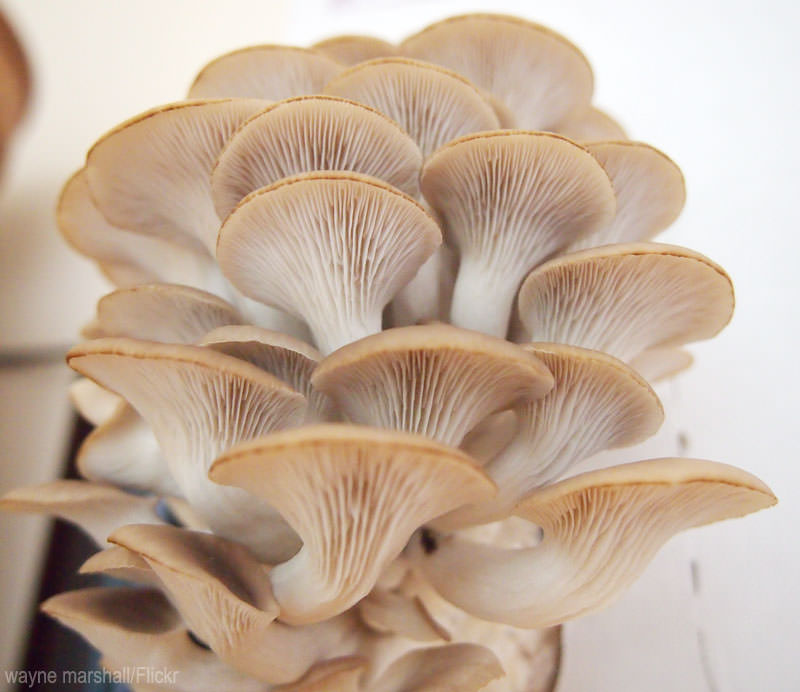
Are you ready to take your home gardening to the next level? Do you want to expand beyond the usual tomatoes and herbs? Why not try growing mushrooms? Gourmet mushrooms can be pricey and sometimes hard to find at your local farmers’ market, so growing them yourself can be a great alternative. Here are three mushrooms any urban farmer can grow, even with limited space.
Getting Started
Mushroom cultivation uses the same basic supplies, no matter what type of mushroom you are growing. The two main requirements are spawn and substrate.
Spawn
Spawn for mushrooms is sort of like seeds for vegetables: It carries the mushroom mycelium and “plants” it wherever you want it to grow. For beginning growers, the spawn is usually purchased from a reputable supplier, typically online or via catalog. (Some larger cities have mushroom-supply shops, as well.)
Substrate
The spawn is then planted in some sort of substrate, such as logs, straw or wood chips. The mycelium will take over and spread until it has enough momentum for the mushrooms to fruit. Mushrooms often fruit several times from the same substrate, but when the mushrooms have thoroughly broken down your growing medium, it makes a great addition to your garden compost.
Choose Your Mushroom
When choosing your mushroom, keep in mind the amount of space and shade you have where you live. Here are three mushrooms any urban farmer can grow, even with limited space.
1. Oyster Mushrooms

Courtesy wayne marshall/Flickr
Oyster mushrooms are one of the simplest mushrooms to grow. Oyster mycelium is very vigorous and can quickly overtake a substrate. There are a variety of ways to grow oysters, but here is a quick and simple one for urban farmers.
Visit your local coffee shop and get a bag of used coffee grounds. These make a great medium for growing mushrooms because the heat of the coffee-making process essentially pasteurizes the grounds and kills off any other organisms that might compete with the mushroom mycelium. Mix the grounds with your oyster spawn in a bucket or storage tub (any size will work), and drill some air holes for circulation. You can store the bucket in your apartment, wherever you have spare, dark space—a closet works great. It’s important to keep the coffee grounds moist by misting them with water as needed.
After about three to four weeks, you should be able to see the white mycelium that has overtaken the coffee grounds. Move the bucket to a spot where it will receive some sunlight, such as on your countertop or near a window. Continue to mist the coffee grounds each day to ensure adequate moisture levels.
In about a week, you should begin to see your oyster mushrooms fruiting. After harvest, you can add some additional coffee grounds and try for another harvest by repeating the process again.
2. Shiitake Mushrooms

Courtesy Christine kaelin/Flickr
Shiitake mushrooms have a rich, earthy flavor that is very different from a typical grocery store button mushroom. You can cultivate them in your backyard by inoculating small (about 4 to 8 inches in diameter), freshly-cut logs or branches.
The inoculating process involves drilling holes in the logs, filling them with spawn and sealing the holes with hot wax. The completed logs simply need a shady area to wait for the mycelium to take over. Consider using a shade tree or space under a porch. The process typically takes around six months. If you don’t have a suitable shady spot in your urban yard, consider building a small awning for your mushrooms logs using a tarp.
After six or so months, you should be able to see mycelium in the form of white spots on the ends of the logs, which means the shiitakes are ready to fruit. You can wait for them to fruit naturally, or you can force them to fruit by soaking them in water for 24 hours. Shiitake logs will fruit several more times over the course of many years depending on the size of the log.
Winecap (Stropharia) Mushrooms

Courtesy Kristine Paulus/Flickr
If you don’t have room for a stand of shiitake logs in your urban yard, consider growing winecap mushrooms. These delicious mushrooms can be planted right in your perennial garden beds or landscape areas.
In the spring, choose an area that is about 16 square feet, and cover it with fresh hardwood wood chips, mixing in your winecap spawn—a 5 pound bag of spawn is ideal for this size project. Soak the area thoroughly. By fall, your wine caps will have sprouted up right among your garden plants. The mycelium also helps keep the soil healthy for your plants, so wine caps are a win-win!
Be sure to clearly identify your winecaps before eating them, as other mushrooms may sprout in your wood chips, as well. Check a mushroom identification guide or look online. Winecaps are reddish-brown in color with dark gills and a fibrous stem.
Harvesting and Storing Your Urban Mushrooms
Harvest mushrooms routinely to avoid damage from insects and prevent them from drying out. Ideally, mushrooms should not be washed in water, but simply wiped clean with a paper towel. Mushrooms are best when used fresh and make a great addition to many different meals, including omelets and stir-fry dishes. You can also store them in the refrigerator to extend their shelf life a few days.
If your harvest outpaces the demand for mushrooms in your kitchen, try drying the excess fungi in a food dehydrator or oven set to 150 degrees F for a couple of hours, turning them occasionally. Dried mushrooms can be rehydrated later for use in soups and stews.





One reply on “3 Mushrooms to Grow in Small Spaces”
[…] identify. The white or pale-gray, fan-shaped mushroom grows in the wild, but it’s also a popular cultivated mushroom for beginning mushroom growers. Oysters grow in close clusters, often found on rotting tree trunks. […]